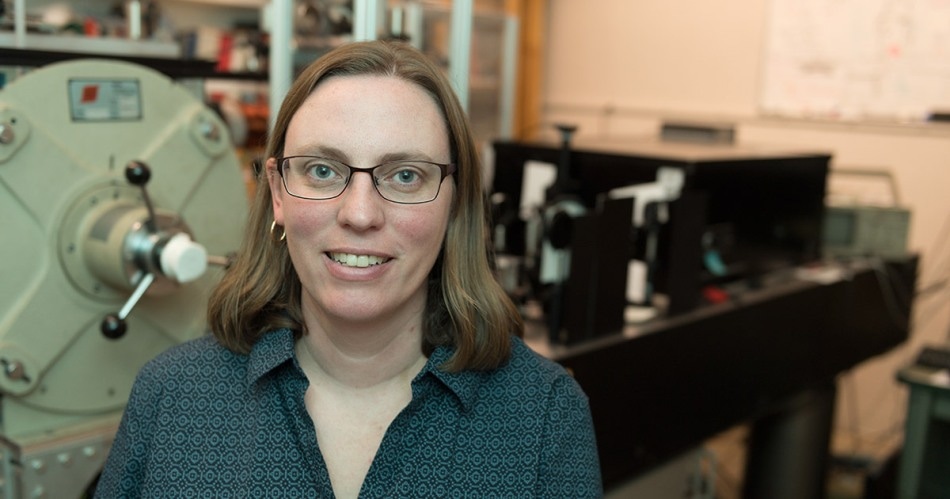Jul 27 2018
The next big progress in digital storage, computer memory, and other electronics is going to be in the form of spins of independent electrons.
 Kristen Buchanan, associate professor in the Department of Physics, and lead investigator on a new grant from the W. M. Keck Foundation. (Image credit: Bill Cotton/Colorado State University)
Kristen Buchanan, associate professor in the Department of Physics, and lead investigator on a new grant from the W. M. Keck Foundation. (Image credit: Bill Cotton/Colorado State University)
The exploitation of electron spin - the phenomenon that makes use of the magnetic fields of each electron as it rotates like a top - is an upcoming frontier in quantum physics known as spintronics. Colorado State University scientists believe they have what it takes to offer unparalleled control of these spinning tops, which are fundamentally bits of information. They will do it by discovering new methods to make, measure, and manipulate ripples that can be introduced through magnetic materials, better known as spin waves. Researchers have suggested and simulated, but not yet achieved, a range of concepts for a novel, nanoscale spin wave circuitry.
Making spin waves with unusually short wavelengths, and building a first-of-its-kind, tabletop soft X-ray microscope to view and examine these waves, are the ambitious goals of a new project sponsored by the W.M. Keck Foundation. A CSU research team led by Kristen Buchanan, associate professor of physics, has been given a three-year, $1 million grant to transform nanoscale electronics using the phenomenon of spin waves as a means to convey signals. If they are fruitful, they will lay the foundation for low-power, non-volatile storage of electronic information, or applications like nanoscale oscillators and quantum computers.
Magnetic materials have already had a huge impact on society through microwave electronics, sensors, and magnetic storage devices. The physics of magnetic materials is quite rich, and there is a lot of potential that is so far untapped to look for new ways to transmit and process information.
Kristen Buchanan, Associate Professor of Physics
Buchanan heads a research group at CSU that creates spin waves and uses light to examine them. But the scientists are restricted in the length scales they can explore by how closely they can focus their light to view them. The funding from the Keck Foundation will enable them to cover their scientific reach to the nanoscale.
Collaborating with Buchanan in the Keck-funded effort will be electrical and computer engineering professors Carmen Menoni, Jorge Rocca and Mario Marconi. Rocca will lead the designing of a new, short-wavelength, tabletop X-ray microscope that is engineered specially to detect spin waves with wavelengths in the 10-to-20 nm regime - an order of magnitude shorter than Buchanan can observe with her current spin wave detection system. This kind of precision from a new X-ray microscope would allow the scientists to reveal central, never-before-observed specifics of spin waves.
Along with Rocca’s years of experience creating short-wavelength, bright laser sources, Menoni and Marconi will provide skill in X-ray optics and imaging. Their knowledge, integrated with Buchanan’s skill in magnetic materials, will reveal solutions to important scientific questions about producing and manipulating spin waves.
One of the concepts the scientists will examine is using magnetic domain walls as a platform for nanoscale, spin wave-based systems. Domain walls are the interfaces between magnetic moments. The scientists hypothesize that these “walls” could act as wire-like channels for the spin waves, eliminating roughness problems connected with patterned wires, and making the new wires effortlessly reconfigurable and rewriteable.
The Keck Foundation is known for aiding high-risk projects with the potential for great scientific payoff projects that otherwise find it hard to get funding. The CSU team’s exclusive blend of expertise in X-ray science, magnetics, optics, and imaging offers a suitable platform for probing vital questions about the upcoming scientific area of spintronics, Buchanan said. The CSU-based partnership will allow the team to maintain flexibility as they partner together, modifying their modeling or experimental approach as required, and working at a faster pace than would be possible otherwise.
Buchanan also highlighted the rich collaborative nature of magnetics research at CSU and throughout the Rocky Mountain region, supported by the Center for Advanced Magnetics, a Program of Research and Scholarly Excellence founded by the Office of the Vice President for Research. The scientists plan to continue interacting with other institutions and discovering new paths for scientific inquiry through the research activity the Keck Foundation is presently supporting.
High-potential research
The Keck Foundation has a long history of aiding CSU science. For instance, chemists Amy Prieto and Jamie Neilson were given a grant in 2016 for their work in engineering new, functional materials. The Keck Foundation also assisted Rocca’s early efforts in extreme UV lasers over ten years ago. This enabled him to set up the NSF Center for Extreme Ultraviolet Science and Technology and formulate a leading program in extreme UV and X-ray laser technology.